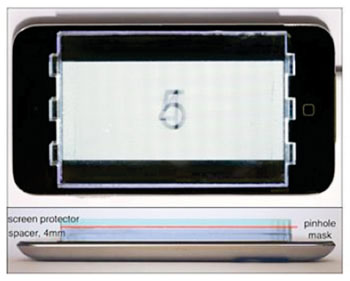Vision-Correcting Display Could Make Glasses Redundant
By HospiMedica International staff writers
Posted on 18 Aug 2014
An innovative computational light field display configuration could one day obviate the need for glasses when using digital displays. Posted on 18 Aug 2014
Researchers at the University of California Berkeley (USA) are developing computer algorithms to compensate for an individual's visual impairment, creating vision-correcting displays that enable users to see text and images clearly without wearing eyeglasses or contact lenses. The algorithm works by adjusting the intensity of each direction of light that emanates from a single pixel in an image, based upon a user's specific visual impairment. To do so, a printed pinhole screen is sandwiched between two layers of clear plastic to enhance image sharpness. The tiny pinholes are 75 micrometers each and spaced 390 micrometers apart.

Image: The deconvolution computational light field display (Photo courtesy of Fu-Chung Huang / Berkeley).
In a process called deconvolution, light passes through the pinhole array in such a way that the user will perceive a sharper image. The technique essentially distorts the image so that when an intended user looks at the screen, the image will appear sharp to that particular viewer; but if someone else were to look at the image, it would look fuzzy. The technology, developed in conjunction with the Massachusetts Institute of Technology (MIT, Cambridge, USA), could potentially help hundreds of millions of people who need corrective lenses to use their smartphones, tablets, and computers.
More importantly, the displays could one day aid people with more complex visual problems that cannot be corrected by eyeglasses, known as high-order aberrations, improve visual acuity. The study describing the technology was presented at the International Conference and Exhibition on Computer Graphics and Interactive Techniques (SIGGRAPH), held during August 2014 in Vancouver (Canada).
“The significance of this project is that instead of relying on optics to correct your vision, we use computation. This is a very different class of correction, and it is nonintrusive,” said lead author Fu-Chung Huang, PhD. “In the future, we also hope to extend this application to multi-way correction on a shared display, so users with different visual problems can view the same screen and see a sharp image.”
“People with higher order aberrations often have irregularities in the shape of the cornea, and this irregular shape makes it very difficult to have a contact lens that will fit,” added senior author Prof. Brian Barsky, PhD. “In some cases, this can be a barrier to holding certain jobs because many workers need to look at a screen as part of their work. This research could transform their lives, and I am passionate about that potential.”
Related Links:
University of California Berkeley
Massachusetts Institute of Technology














